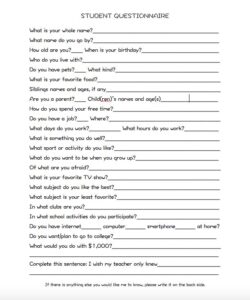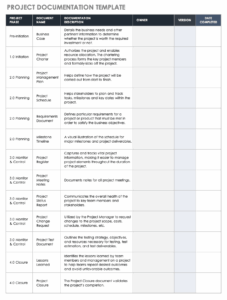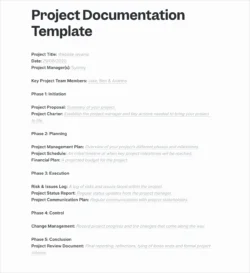So, you’re staring down the barrel of your final year project, huh? Feeling a mix of excitement and sheer panic? That’s totally normal. The project itself is one thing, but then there’s the *documentation*. The word alone can send shivers down the spines of even the most dedicated students. But fear not! Think of your project documentation as your project’s story, a narrative of all the hard work, brilliant ideas, and inevitable setbacks you encountered along the way. It’s your chance to showcase not just the final product, but the entire journey.
Documenting your final year project doesn’t have to be a grueling, soul-crushing task. In fact, with the right approach and a solid final year project documentation template, it can actually be quite manageable. A well-structured template provides a framework, guiding you through the essential sections and ensuring you cover everything important. It’s like having a roadmap, preventing you from getting lost in the vast wilderness of your project details.
This article is designed to be your friendly guide through the world of project documentation. We’ll explore why it’s so crucial, what key elements it should include, and how to use a template to streamline the entire process. We’ll also touch on some common pitfalls to avoid and offer practical tips to make your documentation clear, concise, and even, dare we say, enjoyable. Let’s get started!
Why is Good Documentation So Important?
Let’s face it, writing documentation might not be the most thrilling part of your project. You’d probably rather be coding, designing, or experimenting. But trust us, investing time in thorough and well-organized documentation is an investment in your future. It’s about more than just meeting a requirement; it’s about showcasing your abilities, protecting your work, and even opening doors to future opportunities.
Firstly, your project documentation serves as evidence of your understanding and effort. It demonstrates that you’ve not only completed the project, but that you also grasp the underlying concepts, the challenges you faced, and the solutions you implemented. This is especially important for assessment purposes, as it allows your professors to evaluate your work fairly and comprehensively.
Secondly, documentation ensures the longevity of your project. Imagine someone else (or even your future self!) trying to understand your code or design without any explanation. Comprehensive documentation provides context, explaining the purpose of each component, the dependencies involved, and the rationale behind your design choices. This makes it easier to maintain, update, or even build upon your work in the future.
Thirdly, strong documentation is a valuable asset in your professional portfolio. It demonstrates your ability to communicate technical information clearly and effectively, a skill highly sought after by employers. Think of it as a showcase of your problem-solving skills, your attention to detail, and your commitment to quality. It sets you apart from other candidates and demonstrates your professionalism.
Finally, consider the ethical implications. Proper documentation acknowledges the work of others, giving credit where it’s due. This is crucial for avoiding plagiarism and upholding academic integrity. It also contributes to the collective knowledge base, allowing others to learn from your experiences and build upon your findings. Think of your documentation as a contribution to the wider academic community.
Key Elements of a Final Year Project Documentation Template
Now that we’ve established the importance of documentation, let’s dive into the essential elements that a good final year project documentation template should include. While the specific requirements may vary depending on your institution and field of study, there are some core components that are universally applicable.
First, the introduction is crucial. It’s your chance to set the stage, providing a brief overview of your project, its objectives, and its significance. Think of it as a “hook” that captures the reader’s attention and motivates them to learn more. Clearly state the problem you’re addressing and why it’s important. Briefly outline your proposed solution and the expected outcomes.
Next comes the literature review. This section demonstrates your understanding of the existing research in your area. It’s not just a summary of other people’s work; it’s an analysis of how your project builds upon or differs from existing knowledge. Critically evaluate the relevant literature, identifying gaps, inconsistencies, or limitations that your project aims to address.
Then, we need the methodology. This is where you detail the approach you took to complete your project. Clearly describe the methods you used, whether it’s experimental design, software development, data analysis, or a combination of these. Provide enough detail so that others could replicate your work. Explain why you chose these methods and how they are appropriate for your project’s objectives.
After that the results are important. This section presents your findings in a clear and concise manner. Use tables, graphs, and figures to illustrate your results effectively. Avoid making interpretations or drawing conclusions in this section; simply present the data objectively. Be sure to report both positive and negative results, as even unexpected findings can be valuable.
Last but not least, the discussion and conclusion are needed. This is where you interpret your results, draw conclusions, and discuss the implications of your findings. Relate your results back to the existing literature, highlighting how your project contributes to the field. Discuss the limitations of your work and suggest directions for future research. End with a strong concluding statement that summarizes the key takeaways from your project.
Ultimately, effective project documentation tells a story. It chronicles your journey, showcasing your skills, your understanding, and your contributions. By following a structured final year project documentation template and paying attention to detail, you can create a document that not only meets the requirements but also serves as a valuable asset for your future endeavors.
Now go forth and document! You’ve got this!



